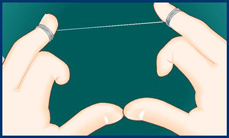Have you been brushing your teeth the wrong way?
Over the course of your lifetime, you’ve probably brushed your teeth thousands of times, but have you been doing it the wrong way all this time? Brushing is something our dentists urge us to do twice a day, every day, but what is the right technique, and why is it time to stop rinsing?
When you clean your teeth, what method do you employ? Do you brush as hard as you can for a while and then spit your toothpaste out and rinse your mouth? If so, stop! Dentists are keen to encourage gentle brushing, and put a stop to rinsing. If you brush hard, you may think that you’re doing a more thorough job. In reality, you may actually be doing more harm than good. This is because brushing vigorously can damage your enamel.
Rinsing has probably been part of your oral care regime for as long as you can remember. There’s nothing dangerous about rinsing, but you may be missing out on the benefits of some ingredients found in your toothpaste. When you rinse immediately after brushing, this rids the mouth of important minerals like fluoride and calcium and ingredients such as Novamin, which are designed to strengthen the enamel and protect your teeth from acid erosion and sensitivity. Rather than rinsing your mouth after brushing, brush, spit, and then you’re done.
Cambridge-based hospital dentist. Dr Thomas O’Connor explained that many patients are unwittingly missing out on the benefits of all the fancy sounding minerals you see listed on the tube of toothpaste because they’re rinsing straight after brushing. It takes time for these minerals to be absorbed, so leaving some of the toothpaste behind is a great way to improve your brushing regime.
Flossing your teeth is an essential part of preventing gum disease and cavities. Flossing removes plaque (plaque is the main cause of gym disease) and bacteria that you cannot reach with your toothbrush. When you do not floss you are missing more than one third of your tooth’s surface. What is plaque? It is an invisible bacterial film that develops on your teeth every day. Plaque hardens within 24-36 hours turning into tartar (also called calculus). Tartar can only be removed with a professional cleaning. Floss at least once a day and the plaque won’t have a chance to harden. Getting into the habit of flossing is easy if you do it while watching television or while listening to music. Take a look at these diagrams and learn the proper way to successfully floss.
How To Floss Your Teeth
Step 1
Take a length of floss equal to the distance from your hand to your shoulder.

Wrap it around your index and middle fingers, leaving about two inches between your hands.

Step 2
Slide the floss between your teeth and wrap it into a “C” shape around the base of the tooth and gently under the gum line. Wipe the tooth from base to tip two or three times.
Step 3
Be sure to floss both sides of every tooth. Don’t forget the backs of your last molars. Go to a new section of the floss as it wears and picks up particles.

Step 4
Brush your teeth after you floss – it is a more effective method of preventing tooth decay and gum disease.

**floss can sometimes shred if it gets snagged on an old filling or jagged tooth. Try using a different type of floss there are many different times available at your local drug store.
** You may notice bleeding from your gums when you first start flossing, this should stop after a few days. If the bleeding does not stop contact your dentist.

